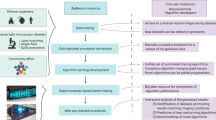Abstract
The accuracy and reliability of automated neurite tracing systems is ultimately limited by image quality as reflected in the signal-to-noise ratio, contrast, and image variability. This paper describes a novel combination of image processing methods that operate on images of neurites captured by confocal and widefield microscopy, and produce synthetic images that are better suited to automated tracing. The algorithms are based on the curvelet transform (for denoising curvilinear structures and local orientation estimation), perceptual grouping by scalar voting (for elimination of non-tubular structures and improvement of neurite continuity while preserving branch points), adaptive focus detection, and depth estimation (for handling widefield images without deconvolution). The proposed methods are fast, and capable of handling large images. Their ability to handle images of unlimited size derives from automated tiling of large images along the lateral dimension, and processing of 3-D images one optical slice at a time. Their speed derives in part from the fact that the core computations are formulated in terms of the Fast Fourier Transform (FFT), and in part from parallel computation on multi-core computers. The methods are simple to apply to new images since they require very few adjustable parameters, all of which are intuitive. Examples of pre-processing DIADEM Challenge images are used to illustrate improved automated tracing resulting from our pre-processing methods.










Similar content being viewed by others
References
Arsenau, S., & Cooperstock, J. R. (2006). An improved representation of junctions through asymmetric tensor diffusion. Advances in Visual Computing, Lecture Notes in Computer Science, 4291, 363–372.
Bell, A. J., & Sejnowski, T. J. (1995). An information-maximization approach to blind separation and blind deconvolution. Neural Computation, 7(6), 1129–1159.
Brown, K. M., Barrionuevo, G., Canty, A. J., De Paola, V., Hirsch, J. A., Jefferis, G. S. X. E., Lu, J., Snippe, M., Sugihara, I., & Ascoli, G. A. (2011). The DIADEM data sets: representative light microscopy images of neuronal morphology to advance automation of digital reconstructions. Neuroinformatics. doi:10.1007/s12021-010-9095-5.
Candes, E. J., Demanet, L., Donoho, D. L., & Ying, L. (2005). Fast discrete curvelet transforms. Multiscale Modeling and Simulation, 5(3), 861–899.
Canero, C., & Radeva, P. (2003). Vesselness enhancement diffusion. Pattern Recognition Letters, 24(16), 3141–3151.
Dempster, A. P., Laird, N. M., & Rubin, D. B. (1977). Maximum likelihood from incomplete data via the EM algorithm. Journal of the Royal Statistical Society: Series B, 39(1), 1–38.
DIADEM, Teams battle for neuron prize (2010), Nature News, vol. 467, 9th September, 2010
Fiji (2010), http://pacific.mpi-cbg.de/wiki/index.php/About
Franken, E., Almsick, M. V., Rongen, P., Florack, L., & Romeny, B. T. H. (2006). An efficient method for tensor voting using steerable filters. Computer Vision - European Conference on Computer Vision 2006, Lectore Notes in Computer Science, 3954, 228–240.
He, W., Hamilton, T. A., Cohen, A. R., et al. (2003). Automated three-dimensional tracing of neurons in confocal and brighfield images, in the proc. of. Microscopy and Microanalysis, 9(4), 296–310.
Huber, P. J. (1981). Robust statistics. New York: Wiley.
Kelly, B. C., & McKay, T. A. (2004). Morphological classification of galaxies by shapelet decomposition in the sloan digital sky survey. The Astronomical Journal, 127, 625–645.
Koffka, K. (1935). Principles of gestalt psychology. New York: Harcourt Brace.
Kornprobst, P., & Medioni, G. (2000). Tracking segmented objects using tensor voting. proc. of IEEE Conference on Computer Vision and Pattern recognition, 2, 118–125.
Lee, T. C., Kashyap, R. L., & Chu, C. N. (1994). Building skeleton models via 3-D medial surface/axis thinning algorithms. Computer Vision, Graphics, and Image Processing, 56(6), 462–478.
Lucy, L. B. (1974). An iterative technique for the rectification of observed distributions. Astronomical Journal, 79(6), 745–754.
Luisi, J., Narayanaswamy, A., Galbreath, Z., Roysam, B. (2011). The FARSIGHT Trace Editor: An Open Source Tool for 3-D Inspection and Efficient Pattern Analysis Aided Editing of Automated Neuronal Reconstructions. Neuroinformatics. doi:10.1007/s12021-011-9115-0.
Meijering, E., Jacob, M., Sarria, J.-C. F., Unser, M. (2003) A novel approach to neurite tracing in fluorescence microscopy images. Intl. Conf. on Signal and Image Processing, pp. 491–495.
Michael, J. Q. (2004) Parallel programming in C with MPI and OpenMP. McGraw-Hill Inc.
Mordohai, P., Medioni, G. (2007). Tensor voting: a perceptual organization approach to computer vision and machine learning. Morgon & Claypool Publishers.
Reisert, M., Burkhardt, H. (2008), Efficient tensor voting with 3-D tensorial harmonics, in Proc. of Computer Vision and Pattern Recognition Workshops, pp. 1–7.
Risser, L., Plouraboue, F., & Descombes, X. (2008). Gap filling of 3-D microvascular networks by tensor voting. IEEE Transactions on Medical Imaging, 27(5), 674–687.
Shao X.-f., Ye L.-w, Cai M.-j., Wang Y. (2008) Simultaneous image denoising and curve extraction by tensor voting. Proc. Intl. Symposium on Computer Science and Computational Technology 536–538.
FARSIGHT Toolkit (2010), http://www.farsight-toolkit.org.
Katznelson and Yitzhak (1976). An introduction to harmonic analysis. Dover. ISBN 0-486-6331-4.
Wang, Y., Narayanaswamy, A., Tsai, C. L., & Roysam, B. (2011). A Broadly Applicable 3-D Neuron Tracing Method Based on Open-Curve Snake. Neuroinformatics. doi:10.1007/S12021-011-9110-5.
Acknowledgements
The authors wish to thank Dr. Marco Reisert (Albert-Ludwigs-Universität Freiburg) for taking his time to share his 3D spherical harmonic tensor voting code (Reisert and Burkhardt 2008) with us and helping us use it. His suggestions on ways to apply 3-D tensor voting to our data have been invaluable. This work was supported primarily by NIH grant R01 EB005157 and by NSF grant EEC-9986821. We would also like to thank the DIADEM organizers and the dataset providers for sharing their data. It really helped us to test our algorithms on a variety of image modalities and compare it with other finalists.
Author information
Authors and Affiliations
Corresponding author
Rights and permissions
About this article
Cite this article
Narayanaswamy, A., Wang, Y. & Roysam, B. 3-D Image Pre-processing Algorithms for Improved Automated Tracing of Neuronal Arbors. Neuroinform 9, 219–231 (2011). https://doi.org/10.1007/s12021-011-9116-z
Published:
Issue Date:
DOI: https://doi.org/10.1007/s12021-011-9116-z




